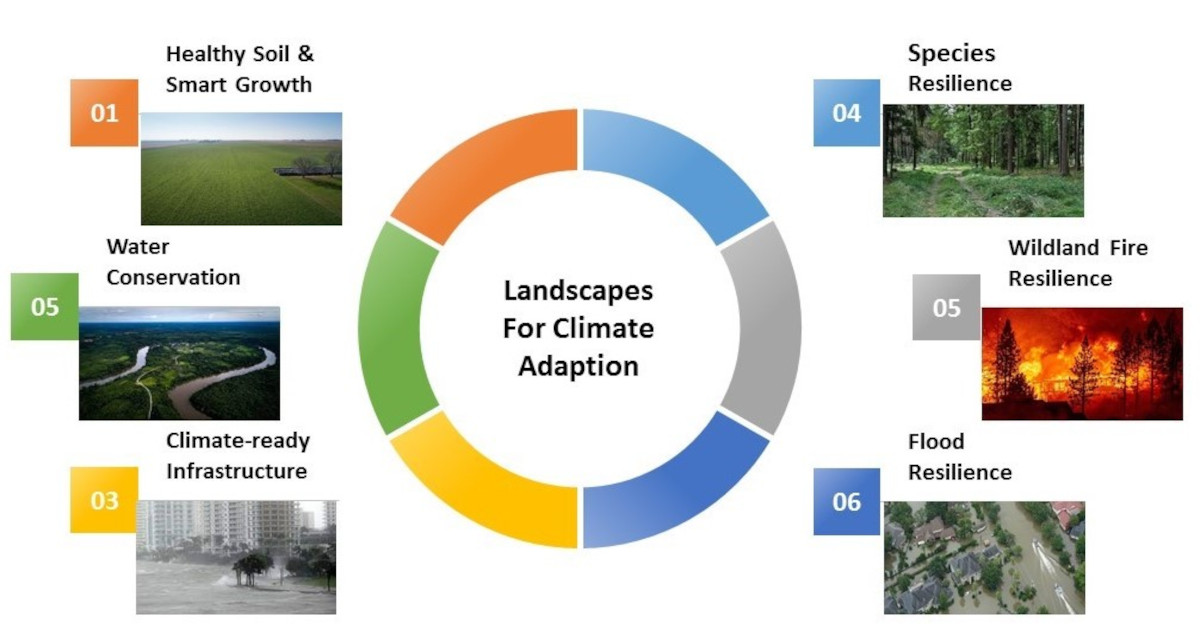Topic Menu
► Topic MenuTopic Editors





What Climate Adaptation Looks Like: Improving Healthy Landscape

Topic Information
Dear Colleagues,
Climate mitigation is one of the most discussed action goals, with over 200 countries pledging their support.
During and after the pandemic, climate adaptation has become more important. World leaders, civil society organizations, scholars, and citizens have been examining aspects of climate change adaptation, resilience, and impacts for many years.
Climate adaption is embedded in a number of different plans and programs that we are following locally, such as our flood hazard and fire emergency management plans. Six of the main ways related to landscapes we are adapting are summarized above.
Therefore, this Topic will seek submissions related to the following themes: achieving sustainability in the farming system; climate-ready buildings and infrastructures; land and water conservation; resilience in species, flood, and wildfire and the role of industry, agriculture, ecosystem, and health sectors.
This call for papers will provide readers from all backgrounds with new policy and strategy ideas on climate change issues.
Furthermore, this work will pave the way for advanced approaches (geo big data, artificial intelligence, open science) to guide future research in the field of climate change.
The topic is planned to bring together academia with the most up-to-date techniques and theoretical expertise to further our understanding of the importance of healthy landscapes to climate adaptation as well as inform policymakers about the stringent action insights required to reach climate adaptation in time.
Dr. Qianqian Zhang
Prof. Dr. Jinman Wang
Prof. Dr. Nisha Bao
Dr. Yang Wang
Dr. Salim Lamine
Topic Editors
Keywords
- human–environment interaction
- landscapes
- resilience
- climate adaption
- land use
Participating Journals
| Journal Name | Impact Factor | CiteScore | Launched Year | First Decision (median) | APC |
|---|---|---|---|---|---|

Climate
|
3.7 | 5.2 | 2013 | 19.7 Days | CHF 1800 |

Ecologies
|
- | - | 2020 | 19.8 Days | CHF 1000 |

Land
|
3.9 | 3.7 | 2012 | 14.8 Days | CHF 2600 |

Remote Sensing
|
5.0 | 7.9 | 2009 | 23 Days | CHF 2700 |

Agronomy
|
3.7 | 5.2 | 2011 | 15.8 Days | CHF 2600 |

MDPI Topics is cooperating with Preprints.org and has built a direct connection between MDPI journals and Preprints.org. Authors are encouraged to enjoy the benefits by posting a preprint at Preprints.org prior to publication:
- Immediately share your ideas ahead of publication and establish your research priority;
- Protect your idea from being stolen with this time-stamped preprint article;
- Enhance the exposure and impact of your research;
- Receive feedback from your peers in advance;
- Have it indexed in Web of Science (Preprint Citation Index), Google Scholar, Crossref, SHARE, PrePubMed, Scilit and Europe PMC.

